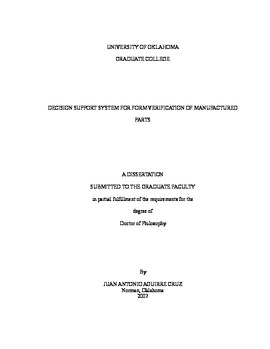| dc.contributor.advisor | Raman, Shivakumar, | en_US |
| dc.contributor.author | Cruz, Juan Antonio Aguirre, | en_US |
| dc.date.accessioned | 2013-08-16T12:20:38Z | |
| dc.date.available | 2013-08-16T12:20:38Z | |
| dc.date.issued | 2007 | en_US |
| dc.identifier.uri | https://hdl.handle.net/11244/1187 | |
| dc.description.abstract | The form verification of manufactured parts is a process composed of a set of operations that are expensive and yet add no value to the product. Yet, the resources used to inspect the parts add a small but significant amount of noise that can affect the outcome of the process. For this reason, this research provides guidelines to effectively perform the inspection process by suggesting new mathematical models and approaches that can be used for the creation of a decision support system that can assist in the verification of the accuracy of machined parts. | en_US |
| dc.description.abstract | This research proposes two approaches to improve the robustness of the mathematical models from the noise induced by the inspection process. The Dynamic Angle Approach (DAA) and the Free Form Orientation approach (FFO) presented here focus on finding the parameters of the axes and origin of the form that counteract the inaccuracies of the inspection equipment. | en_US |
| dc.description.abstract | In summary, this research suggests formalized methods for feature extraction, sampling, path planning, and form fitting, although the last mentioned received the most attention. It is believed that this comprehensive, integrated analysis will lead to the development of a decision support system. | en_US |
| dc.description.abstract | The proposed approaches and mathematical models were verified using measurements from features that were perfectly aligned with the coordinate system of the inspection equipment and from features that were intentionally misaligned. The results showed that the models were accurate and robust enough to estimate the parameters and zone of error of the form features and they performed better than existing models. | en_US |
| dc.description.abstract | The main goal of this research is to develop procedures that are simple to implement but at the same time are robust enough to provide reliable information that help the metrologist to make accurate decisions about the inspected parts. Form features such as spheres, cylinders, cones, frustums, and torus forms are commonly used to design complex parts. However, the procedures to verify most of these form features have not been developed yet by the national standards. Therefore, this research proposes new mathematical models that combine the concepts of analytic geometry and optimization to provide optimal solutions. | en_US |
| dc.format.extent | xiv, 338 leaves : | en_US |
| dc.subject | Metrology. | en_US |
| dc.subject | Manufactures. | en_US |
| dc.subject | Quality of products. | en_US |
| dc.subject | Machining. | en_US |
| dc.subject | Engineering, Industrial. | en_US |
| dc.title | Decision support system for form verification of manufactured parts. | en_US |
| dc.type | Thesis | en_US |
| dc.thesis.degree | Ph.D. | en_US |
| dc.thesis.degreeDiscipline | School of Industrial and Systems Engineering | en_US |
| dc.note | Adviser: Shivakumar Raman. | en_US |
| dc.note | Source: Dissertation Abstracts International, Volume: 68-04, Section: B, page: 2577. | en_US |
| ou.identifier | (UMI)AAI3261110 | en_US |
| ou.group | College of Engineering::School of Industrial and Systems Engineering | |
